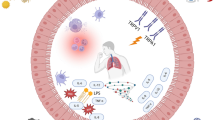Abstract
Autonomic reflexes were investigated in patients with the cardioinhibitory carodid sinus syndrome. Heart rate, blood pressure and forearm blood flow responses were recorded during prolonged head-up tilt, the Valsalva manoeuvre, lower body negative pressure and sequential respiratory cycles in ten patients and nine age-matched controls.
The mean maximum R—R interval prolongation during carotid sinus massage was 4.4 s. Three patients had syncope during prolonged head-up tilt. Heart rate and blood pressure responses were similar for patients and controls who completed tilt. Responses to lower body negative pressure and Valsalva manoeuvre were similar for both groups. Respiratory sinus arrhythmia was significantly less marked in patients, 7 bpm (0 to 20 bpm) versus 15 bpm (6 to 35 bpm;p = 0.05). Therefore, neck massage and deep breathing produce abnormal cardiac vagal responses, whereas other reflexes, including response to lower body negative pressure and the Valsalva manoeuvre are within the normal range in cardioinhibitory carotid sinus syndrome.
Similar content being viewed by others
References
Weiss S, Baker JP. The carotid sinus reflex in health and disease: its role in the causation of fainting and convulsions.Medicine 1933;12: 297–345.
Morley C, Sutton R. Carotid sinus syndrome. Editorial review.Intern J Cardiol 1984;6: 287–293.
McIntosh S, Lawson J, Kenny RA. Clinical characteristics of vasodepressor, cardioinhibitory and mixed carotid sinus syndrome in the elderly.Am J Med 1993;93: in press.
Almquist A, Gornick C, Benson DW, Dunnigan A, Benditt DG. Carotid sinus hypersensitivity: evaluation of the vasodepressor component.Circulation 1985;71: 928–936.
Walter PF, Crawley IS, Dorney ER. Carotid sinus hypersensitivity and syncope.Am J Cardiol 1978;42: 396–403.
Kenny RA, Lyon CC, Ingram AM, Bayliss J, Lightman SL, Sutton R. Enhanced vagal activity and normal arginine vasodepressor response in carotid sinus syndrome: implications for a central abnormality in carotid sinus hypersensitivity.Cardiol Res 1987;21: 545–550.
Kenny RA, Ingram A, Bayliss J, Sutton R. Head-up tilt for unexplained syncope.Lancet 1986;ii: 169–170.
Kenny RA, Bayliss J, Ingram A, Sutton R. Head-up tilt: a useful test for investigating unexplained syncope.Lancet 1986;i: 1352–1354.
Brown E, Goei JS, Greenfield ADM, Dlassaras GC. Circulatory responses to simulated gravitational shifts of blood in man induced by exposure of the body below the iliac crests to sub-atmospheric pressure.J Physiol 1966;183: 607–627.
Ewing DS, Clarke BF. Diagnosis and management of diabetic autonomic neuropathy.Br Med J 1982;285: 916–918.
Greenfield ADM, Whitney RJ, Mowbray JF. Methods for the investigation of peripheral blood flow.Br M Bull 1963;19: 101–109.
Kenny RA, Traynor G. Carotid sinus syndrome—clinical characteristics in elderly patients.Age & Ageing 1991;20: 449–454.
McIntosh S, da Costa D, Kenny, RA. Outcome of an integrated approach to the investigation of dizziness, falls and syncope in elderly patients referred to a ‘syncope’ clinic.Age & Ageing 1993;22: 53–58.
Smith ML, Ellenbogen KA, Eckberg DL. Sympathoinhibition and hypotension in carotid sinus hypersensitivity.Clin Auton Res 1992;2: 389–392.
Morley C, Perrins EJ, Grant P, Chan SL, McBrien DJ, Sutton R. Carotid sinus syncope treated by pacing: analysis of persistent symptoms and the role of atrioventricular sequential pacing.Br Heart J 1982;47: 411–418.
Madigan NP, Flaker GC, Curtis JJ, Reid JJ, Mueller KJ, Murphy TJ. Carotid sinus hypersensitivity: beneficial effects of dual chamber pacing.Am J Cardiol 1984; 1034–1040.
Brignolle M, Menozzi C, Lolli G, Oddone D, Gianfranchi L, Berttulla A. Pacing for carotid sinus syndrome and sick sinus syndrome.PACE 1990;30: 2071–2075.
Mathias CJ, Armstrong E, Browse N, Chaudhuri KR, Enevoldson P, Russell RWR. Value of non-invasive continuous blood pressure monitoring in the detection of corotid sinus hypersensitivity.Clin Auton Res 1991;1: 157–159.
Parchi P, Pierangeli G, Verlicchi A, Cortelli P. Non-invasive continuous cardiovascular monitoring in the vasodepressor form of carotid sinus hypersensitivity—confirmation of its value.Clin Auton Res 1993;3: 81–82.
Imholz BPM, Settells JJ, Van de Meiracken AH, Weiling W. Cardiovascular reflex testing with Finapres: non-invasive beat to beat finger blood pressure responses change of posture compared to invasive measurements.Cardiovasc Res 1990:24: 214–221.
Kenny RA, Dunn HM. Carotid sinus massage in carotid sinus syndrome.Ulster Med J 1990;59: 93–95.
Author information
Authors and Affiliations
Rights and permissions
About this article
Cite this article
Kenny, R.A., Allen, J.A. & Wallace, W.F.M. Autonomic reflexes in patients with cardioinhibitory carotid sinus syncope. Clinical Autonomic Research 3, 101–105 (1993). https://doi.org/10.1007/BF01818994
Received:
Accepted:
Issue Date:
DOI: https://doi.org/10.1007/BF01818994




